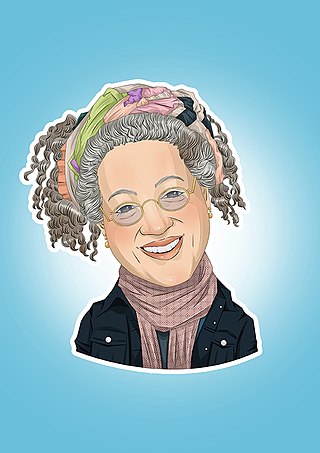Zuzana Licko is a Slovak-born American type designer and visual artist known for co-founding Emigre Fonts, a digital type foundry in Berkeley, CA. She has designed and produced numerous digital typefaces including the popular Mrs Eaves, Modula, Filosofia, and Matrix. As a corresponding interest she also creates ceramic sculptures, textile prints and jacquard weavings.

April Greiman is an American designer widely recognized as one of the first designers to embrace computer technology as a design tool. Greiman is also credited, along with early collaborator Jayme Odgers, with helping to import the European New Wave design style to the US during the late 70s and early 80s." According to design historian Steven Heller, “April Greiman was a bridge between the modern and postmodern, the analog and the digital.” “She is a pivotal proponent of the ‘new typography’ and new wave that defined late twentieth-century graphic design.” Her art combines her Swiss design training with West Coast postmodernism.

Michael Bierut is a graphic designer, design critic and educator, who has been a partner at design firm Pentagram since 1990. He designed the logo for Hillary Clinton's 2016 presidential campaign.
In design, New Wave or Swiss Punk Typography refers to an approach to typography that defies strict grid-based arrangement conventions. Characteristics include inconsistent letterspacing, varying typeweights within single words and type set at non-right angles.

Ellen Lupton is a graphic designer, curator, writer, critic, and educator. Known for her love of typography, Lupton is the Betty Cooke and William O. Steinmetz Design Chair at Maryland Institute College of Art. Previously she was the Senior Curator of Contemporary Design at Cooper Hewitt, Smithsonian Design Museum in New York City and was named Curator Emerita after 30 years of service. She is the founding director of the Graphic Design M.F.A. degree program at Maryland Institute College of Art (MICA), where she also serves as director of the Center for Design Thinking. She has written numerous books on graphic design for a variety of audiences. She has contributed to several publications, including Print, Eye, I.D., Metropolis, and The New York Times.
Paul Scott Makela was a graphic designer, multimedia designer and type designer. Among other work, he was especially noted for the design of Dead History, a postmodern typeface that combined features of a rounded sans serif typeface and a crisp neo-classical serif typeface. With the emergence of the personal computer in the mid-1980s, Makela was among the first to explore digital programs such as Photoshop and Adobe Illustrator. As a result, he created an idiosyncratic, original and highly controversial design aesthetic. In particular, his disregard for clean, modernist, problem-solving design agendas—synonymous with contemporary corporate graphic design—caused much debate among powerful, old-guard designers such as Massimo Vignelli, Paul Rand, and Henry Wolf.
Lorraine Wild is a Canadian-born American graphic designer, writer, art historian, and teacher. She is an AIGA Medalist and principal of Green Dragon Office, a design firm that focuses on collaborative work with artists, architects, curators, editors and publishers. Wild is based in Los Angeles, California.
Edward Fella is an American graphic designer, artist and educator. He created the OutWest typeface in 1993. His work is held in the collection of the Cooper-Hewitt, National Design Museum, the Brauer Museum of Art, and the Museum of Modern Art. He was the recipient of the 2007 AIGA Medal. He was also the recipient of a Chrysler Award in 1997. Curt Cloninger called Fella "the contemporary master of hand-drawn typography."

Debbie Millman is an American writer, educator, artist, curator, and designer who is best known as the host of the podcast Design Matters. She has authored six books and is the President Emeritus of the American Institute of Graphic Arts (AIGA) and chair, one of only five women to hold the position over 100 years. She co-founded the Masters in Branding Program at the School of Visual Arts in New York City with Steven Heller. She was previously the editorial and creative director of Print magazine. Her illustrations have appeared in many major publications, including New York Magazine, Design Observer, and Fast Company and her artwork has been included in many museums and institutes including the Design Museum of Chicago and the Boston Biennale.
Michael McCoy is an American industrial designer and educator who has made significant contributions to American design and design education in the latter half of the 20th century. McCoy is best known as the co-chair of the graduate program in Design at Cranbrook Academy of Art where he and spouse Katherine McCoy pioneered semantic approaches to design.
Peter Seitz was a graphic designer, author, teacher and business owner who served as the first design director at The Walker Art Center, and helped establish the graphic design program at the Minneapolis College of Art and Design.

Lella Vignelli was an Italian architect, designer, and businesswomen. She collaborated closely throughout much of her life with her husband Massimo Vignelli, with whom she founded Vignelli Associates in 1971.
Gere Kavanaugh is an American textile, industrial, and interior designer. She is the principal of Gere Kavanaugh Designs.
Louise Sandhaus is an American graphic designer and design educator. She is a professor at California Institute of the Arts and is principal of Louise Sandhaus Design.

Gail Anderson is an American graphic designer, writer, and educator- known for her typographic skill, hand-lettering and poster design.
Meredith Davis is an educator, writer and graphic designer. Her work centers for advocating for a comprehensive, critical and challenging design education.
Lucille Tenazas is a graphic designer, educator, and the founder of Tenazas Design. Her work consists of layered imagery and typography, focusing on the importance of language. She was born in Manila, Philippines, yet has spent a large portion of her life practicing in the United States.
Vignelli Associates was a design firm co-founded and run by Massimo and Lella Vignelli in New York City, from 1971 to 2014. They worked firmly within the modernist tradition, stressing simplicity by using basic geometric shapes and a limited range of typefaces. Their design work, encompassing graphic design, branding and corporate identity, architecture and interiors, and industrial design is considered among the most influential of the 20th century.
Laurie Haycock Makela is an American graphic designer and educator. She co-chaired the design program at Cranbrook Academy of Art in the 1990s along with her husband, P. Scott Makela. Both were honored with the AIGA medal in 2000.





